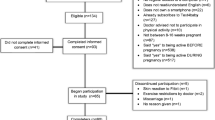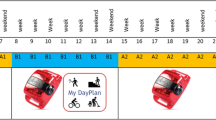Abstract
Text4baby is a free, mobile health information service for pregnant and post-partum women. This study aims to understand preferences of physical activity text messages (SMS), sequentially develop prototype SMS, and determine preferred dose of SMS to inform a future study utilizing Text4baby. This study had a user-centered design with three phases: (1) literature review and interviews with pregnant women for development of prototype SMS, (2) interviews with health care professionals and pregnant women for prototype SMS feedback, and (3) survey to determine preferred dose of SMS. Data from interviews identified knowledge and support as major themes. Prototypes were developed (N = 14) and informed 168 SMS. Pregnant women (N = 326) thought three SMS/week were about right (50.2 %) and preferred three SMS/week throughout pregnancy (71.9 %). There is a need for opportunities for behavioral scientists to incorporate evidence-based practices within scalable interventions. As such, this research will inform utilization of Text4baby to potentially improve physical activity participation.

Similar content being viewed by others
References
Clapp JF III, Lopez B, Harcar-Sevcik R. Neonatal behavioral profile of the offspring of women who continued to exercise regularly throughout pregnancy. Am J Obstet Gynecol. 1999; 180(1): 91-94.
Dempsey JC, Butler CL, Williams MA. No need for a pregnant pause: physical activity may reduce the occurrence of gestational diabetes mellitus and preeclampsia. Exerc Sport Sci Rev. 2005; 33(3): 141-149.
Melzer K, Schutz Y, Boulvain M, et al. Physical activity and pregnancy. J Sports Med. 2010; 40(6): 493-507.
Doran F, Davis K. Factors that influence physical activity for pregnant and postpartum women and implications for primary care. Aust J Prim Health. 2011; 17(1): 79-85.
Chu SY, Callaghan WM, Kim SY, et al. Maternal obesity and risk of gestational diabetes mellitus. Diabetes Care. 2007; 30(8): 2070-2076.
Evenson KR, Savitz DA, Huston SL. Leisure time physical activity among pregnant women in the US. Paediatr Perinat Epidemiol. 2004; 18(6): 400-407.
Melzer K, Schutz Y, Soehnchen N, et al. Effects of recommended levels of physical activity on pregnancy outcomes. Am J Obstet Gynecol. 2010; 202(3): 266-e1.
Brenner IK, Wolfe LA, Monga M, et al. Physical conditioning effects on fetal heart rate responses to graded maternal exercise. Med Sci Sports Exerc. 1999; 31(6): 792-799.
Clapp JF III, Kim H, Burciu B, et al. Beginning regular exercise in early pregnancy: effect on fetoplacental growth. Am J Obstet Gynecol. 2000; 183(6): 1484-1488.
Gustafson KM, May LE, Yeh HW, et al. Fetal cardiac autonomic control during breathing and non-breathing epochs: the effect of maternal exercise. Early Hum Dev. 2012; 88(7): 539-546.
May LE, Glaros A, Yeh HW, et al. Aerobic exercise during pregnancy influences fetal cardiac autonomic control of heart rate and heart rate variability. Early Hum Dev. 2010; 86(4): 213-217.
May LE, Suminski RR, Langaker MD, et al. Regular maternal exercise dose and fetal heart outcome. Med Sci Sports Exerc. 2012; 44(7): 1252-1258.
Fell DB, Armson KS, Dodds L. The impact of pregnancy on physical activity level. Matern Child Health J. 2009; 13(5): 597-603.
Gaston A, Cramp A. Exercise during pregnancy: a review of patterns and determinants. J Sports Sci Med. 2011; 14(4): 299-305.
American College of Obstetricians and Gynecologists (ACOG) Committee on Obstetric Practice. Committee opinion #267: exercise during pregnancy and the postpartum period. Obstet Gynecol. 2002; 99(1): 171-173.
American College of Sports Medicine (ACSM). About ACSM: News Releases: PA Recommendations. Updated in 2011. Retrieved from http://www.acsm.org/about-acsm/media-room/news-releases/2011/08/01/acsm-issues-new-recommendations-on-quantity-and-quality-of-exercise on August 16, 2013.
Center for Disease Control and Prevention (CDC). How much physical activity do adults need? Updated in 2011. Retrieved from http://www.cdc.gov/physicalactivity/everyone/guidelines/adults.html on August 16, 2013.
Campbell F, Johnson M, Messina J, et al. Behavioural interventions for weight management in pregnancy: a systematic review of quantitative and qualitative data. BMC Public Health. 2011; 22(11): 491-514.
Chang MW, Nitzke S, Guilford E, et al. Motivators and barriers to healthful eating and physical activity among low-income overweight and obese mothers. J Am Diet Assoc. 2008; 108(6): 1023-1028.
Huberty J, Dinkel D, Beets MW, et al. Describing the use of the internet for health, physical activity, and nutrition information in pregnant women. Matern Child Health J. 2013; 17(8): 1363-1372.
Szwajcer EM, Hiddink GJ, Maas L, et al. Nutrition-related information-seeking behaviours of women trying to conceive and pregnant women: evidence for the life course perspective. Fam Pract. 2008; 25(Suppl 1): i99-i104.
Leiferman J, Sinatra E, Huberty J. Pregnant women’s perceptions of patient-provider communication for health behavior change during pregnancy. Open J Obstet Gynecol. 2014; 4(11): 672-684.
Cannella D, Lobel M, Monheit A. Knowing is believing: information and attitudes towards physical activity during pregnancy. J Psychosom Obstet Gynaecol. 2010; 31(4): 236-242.
Cheyney M, Moreno-Black G. Nutritional counseling in midwifery and obstetric practice. Ecol Food Nutr. 2010; 49(1): 1-29.
Kivits J. Informed patients and the internet: a mediated context for consultations with health professionals. J Health Psychol. 2006; 11(2): 269-282.
Cummins CO, Prochaska JO, Driskell MM, et al. Development of review criteria to evaluate health behavior change websites. J Health Psychol. 2003; 8(1): 55-62.
Eysenbach G, Kohler C. How do consumers search for and appraise health information on the world wide web? Qualitative study using focus groups, usability tests, and in-depth interviews. BMJ. 2002; 324(7337): 573-577.
Spruijt-Metz D, Nilsen W. Dynamic models of behavior for just-in-time adaptive interventions. IEEE Pervasive Comput. 2014; 13(3): 13-17.
Cohall A, Hyden C. Rx for a healthy practice. Get the message? Text messaging in primary care settings. Contemp Pediatr. 2008; 25(11): 57-61.
Cole-Lewis H, Kershaw T. Text messaging as a tool for behavior change in disease prevention and management. Epidemiol Rev. 2010; 32(1): 56-69.
Fjeldsoe BS, Miller YD, Marshall AL. MobileMums: a randomized controlled trial of an SMS-based physical activity intervention. Ann Behav Med. 2010; 39(2): 101-111.
Gerber BS, Stolley MR, Thompson AL, et al. Mobile phone text messaging to promote healthy behaviors and weight loss maintenance: a feasibility study. Health Informatics J. 2009; 15(1): 17-25.
Haller D, Sanci L, Sawyer S, et al. R U OK 2 TXT 4 Research? Feasibility of text messaging communication in primary care research. Aust Fam Physician. 2006; 35(5): 175-176.
Hurling R, Catt M, Boni MD, et al. Using internet and mobile phone technology to deliver an automated physical activity program: randomized controlled trial. J Med Internet Res. 2007; 9(2): e7.
Krishna S, Boren S, Balas EA. Healthcare via cell phones: a systematic review. Telemed J E Health. 2009; 15(3): 231-240.
Rice R, Katz J. Comparing internet and mobile phone usage: digital divides of usage, adoption and dropouts. Telecommun Policy. 2003; 27(8): 597-623.
Demiris G, Afrin LB, Speedie S, et al. Patient-centered applications: use of information technology to promote disease management and wellness. A white paper by the AMIA knowledge in motion working group. J Am Med Inform Assoc. 2008; 15(1): 8-13.
Fox S, Duggan M. (2012). Mobile health 2012. Pew Research Center’s Internet x0026 American Life Project [Internet]. Retrieved from: http://emr-matrix.org/wp-content/uploads/2012/12/PIP_MobileHealth2012.pdf on January 23rd, 2015.
Gazmararian JA, Elon L, Yang B, et al. Text4baby program: an opportunity to reach underserved pregnant and postpartum women? Matern Child Health J. 2014; 18: 223-232.
Evans WD, Wallace JL, Snider J. Pilot evaluation of the text4baby mobile health program. BMC Public Health. 2012; 12: 1031.
Text4Baby Enrollment Data. Text4Baby Website. https://www.text4baby.org/index.php/partner-resources/105-text4baby-enrollment-data Published February 2nd, 2010. Updated January 17th, 2015. Accessed January 22nd, 2015.
Bowen DJ, Kreuter M, Spring B, et al. How we design feasibility studies. Am J Prev Med. 2009; 36(5): 452-457.
Leon AC, Davis LL, Kraemer HC. The role and interpretation of pilot studies in clinical research. J Psychiatr Res. 2011; 45(5): 626-629.
McClain AD, Hekler EB, Gardner C. Incorporating prototyping and iteration into intervention development: a case study of a dining hall-based intervention. J Am Coll Heal. 2013; 61(2): 122-131.
Fieril KP, Olsén MF, Glantz A, Larsson M. Experiences of exercise during pregnancy among women who perform regular resistance training: a qualitative study. Phys Ther. 2014; 94(8): 1135-43.
Leiferman J, Swibas T, Koiness K, et al. My baby, my move: examination of perceived barriers and motivating factors related to antenatal physical activity. J Midwifery Womens Health. 2011; 56(1): 33-40.
Creswell JW. Qualitative inquiry and research design: choosing among five approaches. London: Sage publications; 2012.
Miles MB, Huberman AM. Qualitative data analysis: an expanded sourcebook. Thousand Oaks: Sage publications; 1994.
Creswell JW. Qualitative inquiry and research design: choosing among five approaches. Thousand Oaks: SAGE Publications Inc; 2007.
Cooper J, Brandon P, Lindberg M. Using peer debriefing in the final stage of evaluation with implications for qualitative research: three impressionist tales. Paper presented at: Annual meeting of the American Educational Research Association; March 1997; Chicago Illinois.
The HON code of conduct for medical and health web sites. Health On the Net Code. http://www.hon.ch/HONcode/Conduct.html. Published April 1997. Updated September 19th, 2013. Accessed January 22nd, 2015.
Corp IBM. IBM SPSS Statistics for Windows, Version 21.0. IBM Corp.: Armonk, NY; 2012.
White JL, Randsdell LB, Vener J, et al. Factors related to physical activity adherence in women: review and suggestions for future research. Women Health. 2005; 41(4): 123-148.
Perry C, Hoffman B. Assessing tribal youth physical activity and programming using a community-based participatory research approach. Public Health Nurs. 2010; 27(2): 104-114.
Wen K, Miller S, Kilby L, Fleisher L, Belton T, Roy G, et al. Preventing postpartum smoking relapse among inner city women: development of a theory-based and evidence-guided text messaging intervention. J Med Internet Res. 2014; 3(2).
Head KJ, Noar SM, Iannarino NT, Grant-Harrington N. Efficacy of text messaging-based interventions for health promotion: a meta-analysis. Soc Sci Med. 2013; 97: 41-48.
Cole-lewis H, Kershaw T. Text messaging as a tool for behavior change in disease prevention and management. Epidemiol Rev. 2008; 32(1): 56-69.
Acknowledgments
This paper was supported by the Virginia G. Piper Charitable Trust.
Conflict of interest
The authors declare that they have no conflict of interests.
Adherence to ethical standards
All procedures were conducted in accordance with the ethical standards of the responsible committee on human experimentation (institutional and national) and with the Helsinki Declaration of 1975, as revised in 2000.
Author information
Authors and Affiliations
Corresponding author
Additional information
Implications
Practice: To use an already existing, free, mobile health service, Text4baby, as an opportunity to disseminate physical activity messages to pregnant and post-partum women.
Policy: Health care providers could easily, with little resources (i.e., time, money) use Text4baby to refer patients to evidence-based information about physical activity during and after pregnancy.
Research: Research to determine the optimal dose of physical activity text messages within the Text4baby curriculum to improve physical activity participation in pregnant women is needed.
About this article
Cite this article
Huberty, J., Rowedder, L., Hekler, E. et al. Development and design of an intervention to improve physical activity in pregnant women using Text4baby. Behav. Med. Pract. Policy Res. 6, 285–294 (2016). https://doi.org/10.1007/s13142-015-0339-7
Published:
Issue Date:
DOI: https://doi.org/10.1007/s13142-015-0339-7




